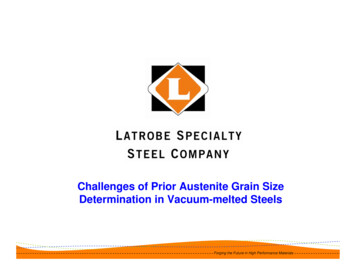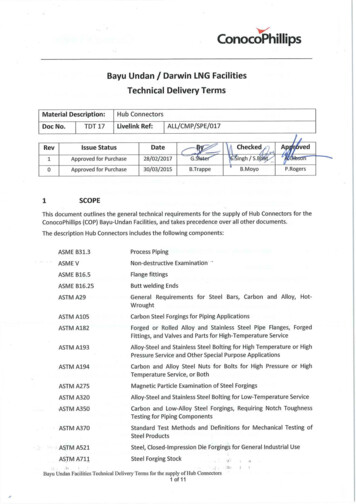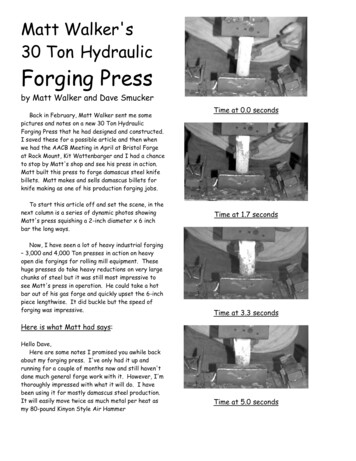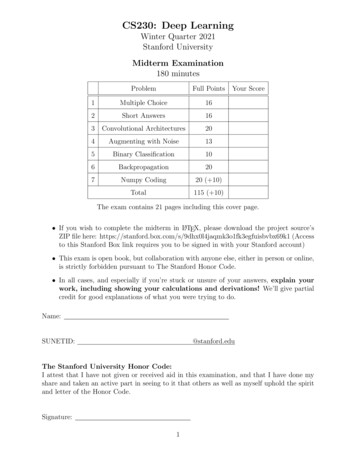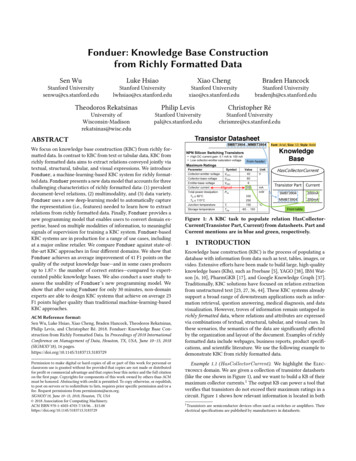
Transcription
Vysoká škola báňská – Technická univerzita OstravaFORGINGDidactic TextMiroslav GregerOstrava 2014
Description: FORGINGAuthor:Miroslav GregerEdition:first, 2014Pages:176Academic materials for the Metallurgy engineering study programme at the Faculty ofMetallurgy and Materials Engineering.Proofreading: none.Project designation:Operation Programme of Education towards Competitive StrengthDescription: ModIn - Modular innovation of bachelor and subsequent master programmes atthe Faculty of Metallurgy and Materials Engineering of VŠB - TU OstravaRef. No.: CZ.1.07/2.2.00/28.0304Realisation: VŠB – Technical University of Ostrava Miroslav Greger VŠB – Technical University of Ostrava
Contents1. Current trends and developments in open die forging of large forged pieces .22. Metal forming machines .173. Heating in forges .274. Heating furnaces and heating in forges .365. Level of through-forging and basic forging operations 456. Effect of forging procedure on closing imperfections in forgings .637. Technological procedures for forging of longitudinal forged pieces 728. Drop forging on hammers . 849. Technological procedure for drop forging 9510. Drop forging on presses 10611. Drop forging on horizontal forging machines 11412. Heat treatment and requirement to properties of forgings 12713. Defects of forgings .13614. Consumption of energy in forges .14915. Die forging perspectives .1611
1. Current trends and developments in open dieforging of large forged piecesChapter contents: Production assortment of forges in the Czech RepublicForges in the Czech RepublicForeign manufacturers and suppliers of open die forgingsTime needed for studying: 90 minutesAim: After studying this chapter you will Gain a basic idea of assortment of manufactured forgings Become acquainted with the forging industry abroad Gain an overview of manufacturers of open die forgings in the CzechRepublicExplicationAt present the demand for large open die forgings has decreased. New investments forbuilding-up new facilities of large forging shops depend on current orders. The articlesurveys the state of chosen forging plants both in the world and in the Czech Republic.The forges for manufacture open die forgings have a wide spectrum of products, in terms ofshape and size, materials, and the spectrum of customers. There is a single-part production orshort-run production at best. Most forgings are intended for external customers in machinedand unmachined states. Only of a small part of forgings, we can say that the interest in them isstable. Sales of the most of them vary during long periods. As a typical example of that factwe can mention forgings for nuclear power plants. 30-40 years ago the capacity of the most ofour manufacturers of open die forgings were overloaded by them, and then the interest inthem dropped almost to zero, but recently the interest has increased again. Large fluctuationsin demand occur also with forgings for shipbuilding industry and with certain other forginggroups.1. General development trendsAs for the machinery is concerned only power hammers for smaller forgings were kept andfrom approximately 1 tonne and more they were replaced by small presses. Moreover, thenumber of radial forging machines even for large cross-section rods and bars has increased. Inthe last 10 years 30 forging presses of press power greater than 100 MN at least have beenbuilt, which was usually related to expectations of a boom in the field of nuclear energy.Forging manipulators have become commonplace even in the largest forging presses. In the2
forges, in the assortment of which rods and bars forged on presses predominate, there areinstalled two forging manipulators on the only one press. In some forges there oxy-cuttingmachines were installed for cutting forgings ends or for their possible dividing.As regards the starting material in smaller forgings manufacture of semi-finished castingproducts have broken through. Today it is possible to make semi-finished casting products upto their diameter of 800 mm, which can replace even rather large ingots. It has becomecommonplace to insulate even more better ingots heads, which makes it possible to work withless waste. And the electroslag remelting of ingots, mainly from tool steel has spread. And theproportion of special steels and alloys has increased too.The assortment of forgings is largely unchanged. However, the proportion of smooth forgedroll and square bars and even bars and rods of large cross sections has increased.Requirements on quality and on the extent of testing have increased in the long-term, as well.Demands on quality are mainly related to the branches for which the forgings are destined.The unpleasant fact is that in many cases it is necessary to change over to some larger typeswhich require larger sizes of forgings, which make achieving the necessary qualityparameters more difficult. The forges manufactured open die forgings have some fields withguaranteed sales of these forgings. In the first place there is today the power engineering thatcan be classified into thermal power plants, nuclear power plants and wind-power plants. Forthermal power plants there are manufactured primarily shafts for turbines and generators. It isa number of sizes, and it is required not only a high purity of steel but also mechanicalproperties reachable with difficulties for reasons of very large diameters of these shafts.However, the interest in these forgings is quite stable. For nuclear power engineering there ismanufactured a wide range of forgings. The challenging forgings include forged pieces withsockets, shaped bottoms, tube plates, parts of piping, and others. The interest in forgings inthis branch is very changeable. For wind-power plants there are forged namely shafts andrings (Fig. 1).Fig.1 The forging for wind-power plant2. Development of free forges abroadFor forging of the largest forged pieces, e.g. for a pressure vessel of the EPR reactorsAP1000 the required press power is 150 MN and an ingot weight 350 t, at least. In thesedays some suitable capacities for forging heavy forged pieces can be found out in Japan(Japan Steel Works), in China (China First Heavy Industries and China Erzhong) in theSouth Korea (Doosan), in France (Le Creusot), in Russia (OMZ Izhora.), and partly also inthe Czech Republic (Pilsen steel, Vítkovice Heavy Machinery). New premises are planned in3
the Great Britain (Sheffield Forgemasters), in India (Larsen & Toubro, Bharat Forge Ltd.).The overview of the producers of large forged pieces is given in the Table 1.Table 1. The overview of big manufacturers of open die forgings, forging presses and max.weights of forged ingotsCountry,regionCompanyJapanJapan Steel WorksJCFCSouth Korea DoosanChinaCFHIHarbin BoilerShanghai (SEC)China Erzhong DongfangIndiaL&TEuropeRussiaThe U.S.A.BHELBharat ForgeAreva, SFARsteelSheffieldPilsen SteelVÍTKOVICESaarschmiedeOMZ IzhoraLehighForgingpresses[MN]till 2010Forgingpresses[MN]after 2013140130150; 12580120127; 160140 x 2130170the samethe same165the same9015011310010212086.7120100100140the same150?120the samethe same150the sameMax. ingotweight[t](2013)600 (650)500540600600600600 (in theyear 2011)250500 ?200 (250)2502006002702.1 Japan Steel Works (JSW)The biggest and most famous supplier of heavy forgings is the Japan Steel Works (JSW).They produce large forgings for reactor pressure vessels, steam generators, turbine shafts, shipdrive shafts, and they supply 80% of the world market by large forged parts for nuclear powerplants. The JSW operate hydraulic forging presses from 30 to MN 140 MN in their plant inMuroran, and they also supply steel ingots up to 600-ton made in their own steel plant (Fig.1). In the year 2010 they put into operation the second forging press of 140 MN. The forgesupplies other components for nuclear power plants and shipbuilding industry: pressurizers,generators and turbine rotors, crankshafts, piping for primary circuits of nuclear power plantsand steel rolls (Fig. 3) and other large forgings. At the present time for forgings of large rollsfor work in cold state there are increasingly used steels of higher strength as e.g. 5% Cr-Mosteel which hardness is about 70 HRC, which increases their wear resistance [1].4
Fig. 2 Ingot of weight 600 tFig. 3 Machined forging of a roll of steel 5% Cr –MoThe steel is melted and refined in a 120-ton electric arc furnace, the content of gases andimpurities can be reduced by ladle refining and then it is cast in vacuum. Maximum ingotweight is 600 t, it is the heaviest in the world. For the treatment of high alloy steels and alloysthere is used electroslag remelting (ESR) to 100t. After heating to the upper forgingtemperature the ingots are forged on a selected hydraulic press. The forge disposes of presses30 MN, 80MN and of two presses 140 MN.After finish forging a preliminary heat treatment is performed. The aim of the heat treatmentafter the roughing is to obtain the desired mechanical properties and a fine structure of theforging.2.2 Japan Casting & Forging Corporation (JCFC)Together with the Kobe Steel they have expanded on the market with heavy forgings. TheJCFC operated the press of 80 MN and in the year 2010 they put into operation the forgingpress of 130 MN and they are able to handle even 500-ton ingots. For the oil industry theKobe Steel company supplies forged pressure vessels composed up to weight of 2,000 t. Theirdiameters may be up to 6.8 m and the wall thickness up to 450 mm [6]. They participatesignificantly in the global market of large marine crankshafts (Fig. 4). The products of theKobe Steel and the JCFC have acquired an excellent reputation in the international markets.Besides the crankshafts for seagoing ships they supply cardan shafts, rotors and blades of5
turbines for the power industry and they also manufacture a wide assortment of metallicmoulds for plastic.Fig.4 The forging of a ship crankshaft forged by the TR method2.3 Doosan Heavy IndustriesThey are currently increasing their capacities making essential investments in casting and freeforging. In the year 2010 they installed a forging press of 170 MN. In the plant Changwonthere is a press of 130 MN used for open die forging. For the Westinghouse they supplypressure vessels for a reactor and steam generators [2]. The Doosan Company has concludedan agreement with the China National Nuclear Corporation (CNNC) on deliveries of heavyforgings and equipment for other projects in China, for Nuclear Power Plant of 1000 MWe. Inthe year 2009 they purchased the Czech ŠKODA POWER.2.4 Heavy Industries (CFHI)In the year 2006 they installed a hydraulic press of 150 MN, at that time the largest in theworld. For open die forging they also use a press of 125 MN. In June 2009 they casted andforged ingot of 580 t. Nowadays they can double their production of liquid steel and expandthe annual capacity of the forge for open die forging to 240 thousand tons.2.5 Electric Group Heavy Industries Corporation (SEC)The Company was founded as early as in the year 1925. Since the year 2008 they havesupplied pressure vessels, steam generators and other parts for the PWRs. In the year 2005a press of 125 MN and also a forging press of 165 MN were operated in the forge. At presentthere are forged some parts for steam generators as well as parts for NPP made of ingots withthe weight up to 600 t. The steel plant has got its capacity of about 500 thousand tons of steel/year and so it is able to supply at real time up to 700 t of molten steel, to cast ingots ofweights 600 t, 500 t, and to forge ingots up to weight of 400 t. The forge capacity is 240thousand tons/year.For steel melting there are used electric furnaces of 160t/130t/40t. For ladle refining there areused ladle (refining) furnaces of 100t/80t/40t and vacuum die casting of ingots is carried outin the boxes of 600t/350t/250t/150t/60t.In the forge there are installed hydraulic presses: 150 MN, 100 MN, 60 MN, they areoperated by the manipulators of 630 tm, 400 tm and 200 tm.6
2.6 China National Erzhong Group Co LtdThey started the production in the year 1971 and they have become the largest base of heavyengineering in China. The CNEG can produce 600-ton ingots and for forging there is used ahydraulic press of 127 MN. In the year 2009 a new hydraulic press of 160 MN was installedin the forge. As for products the forge is focused on 1,100 MW low-speed generator rotorsfor the Dongfang Electric. In the year 2010 there was installed a press of 80 MN for dropforging of parts for the aircraft industry.2.7 Shandong Nuclear Power Equipment Manufacturing Co Ltd(SNPEMC)The Company was established in the year 2009. For forging, there is used a press of 80 MN.The parent company, the Harbin Power Equipment Co Ltd (HPEC), delivers steam turbinesand generators of 1,200 MWe [3].2.8 Larsen & Toubro Ltd.It is the biggest engineering and building company in India. They supply reactor pressurevessels for the PHWR reactors and parts of power breed reactors and steam generators. Theforge is equipped by a press of 90 MN. There is a project ready for building-up a press of150MN for manufacture of ultra-large forgings. They can deliver equipment, steamgenerators, the individual forgings for pressure vessels (Fig.5), primary piping, controlsystems and they can also provide services for almost all PHWR reactors both in India andabroada)b)Fig. 5 Ring forging (a) and ring forged piece (b)7
2.9 Bharat Heavy Electricals (BHEL) a Bharat Forge Ltd (BFL)It is a supranational company and it counts among the biggest and technologically mostadvanced producers of forged and machined parts, namely for the automotive industry. Atpresent they are expanding to the power-producing sector. They will deliver components fornuclear power plants with the power outputs of 700 MWe, 1000 MWe and 1600 MWe , andthey are planning installation of a forging press of 100 MN (Fig. 6).Fig. 6 Forging on the press of 100 MN2.10 Areva a Areva Creusot ForgeIn the year 2006 they acquired the French SFARsteel, one of the world’s leading producers oflarge forged parts (Fig. 7). In Europe they enjoy a very good geographical strategic locationfor manufacture of very heavy components weighing up to 360 t, and further pressure vesselsfor reactors, as well as steam generators. They utilize a forging press of 113 MN and a pressof 75 MN. The Areva Creusot Forge is a subsidiary company in Burgundy. They specialize inlarge forgings. And recently they have invested in order to increase their production of heavycomponents for nuclear power engineering, including big pressure vessels of reactors [4].They specialize in forging of rings with branch extrusion for the EPRs, and they processingots of weight up to 500 tons, which is currently carried out only by the JSW.Fig. 7 The scheme of forging of a neck ring part for pressure vessel of the EPR reactor.8
2.11 Sheffield Forgemasters International,The company was founded as early as in the year 1750. At present they operate a press of100 MN (Fig. 8), on which they manufacture 300-tun ingots Their intention is to invest toinstallation of a press of 150 MN for forging ingots up to 500 t. At present time the forge isequipped with:Forging press of 100 MN being served by a rail manipulator of 300 tm, the workplace isfully integrated and it is controlled centrally by a computer. For the press operatingthere are even three bridge cranes (2 330 t 100 t), and auxiliary cranes (1 120 t )and 40 t for service ensuring, 40 MN-press being equipped with a rail manipulator (80 mt), the workplace is fullyintegrated, with forging to the dimension with the accuracy of 1mm, 25 MN-press with a rail manipulator of 50 tm and a mobile manipulator of 8 t. Thepress workplace by 2 bridge cranes (1 70 t 15 t) a (1 30 t 10 t), Up-to-date heating furnaces being heated by natural gas and equipped withsophisticated control elements for ensuring the accurate temperature, Comprehensive equipment with smith’s tool to creation both hollow and solid forgingsof irregular shapes weighing up to 200 t, with ensuring an extremely precise control ofsizes and optimum metallurgical properties of forgings. Gas horizontal furnaces controlled by a computer of their capacity up to 250 t withsuccessive heat treatment (Fig. 9), and successive hardening in oil, in water andtempering,Vertical electric resistance furnace of maximum sizes of manufactured forgings with thediameter of 3.7 m, the furnace depth is 21.5 m . The Sheffield Forgemasters International manufactured heavy forgings for British nuclearpower plants.Fig. 8 Hydraulic press of 100 MN for open die forging9
Fig. 9 Heat treatment of longitudinal forgingsMaximal dimensions of forgings: of the shaft: D 3,000 mm, length L 25,000 mm; rings 5,000 mm; hollow bodies D 4,300 mm; circular plates D 5,500 mm2.12 OMZ je Izhorskiye ZavodyIn the year 2008 when the company completed the first phase of rebuilding of its 120 MNhydraulic press they claimed to be the largest in Europe. In the second phase the powercapabilities of the press were increased to 150 MN. In mid 2009 the steel plant enabling thecomplex manufacture of 600 ton-ingots with the diameter of 5.5 m was put into operation.With utilization the 600 ton-ingot the capacity of the forge was increased. Among forgingscan be included parts for the reactor pressure vessels, steam generators, pressurizers, piping ofprimary circuits, and other heavy forgings.Fig. 10 Heat processing of a roughed-out ringThe OMZ Group is one of the five biggest world’s leading producers of large and very largespecial steel forgings destined for conventional and nuclear power engineering, metallurgyand mechanical engineering, petro-chemistry, and also for other strategic branches. Togetherwith the Japan Steel Works, Japan Casting & Forging Corporation (JCFC), Kobe Steel Groupand Doosan Heavy Industries & Construction Co, that are able to manufacture huge and veryspecial products of steel for conventional and nuclear power engineering, metallurgy andmechanical engineering the OMZ uses four hydraulic forging presses for manufacture offorgings of special steel. So, they are able to manufacture and deliver a wide assortment of10
forgings of weights ranging from 150 kg to 245 t, with dimensions from 3,500 mm, rings ofdiameters up to 6,500 mm (Fig.10), and longitudinal forgings of their lengths up to 20,000mm.2.15 Lehigh Heavy Forge, PennsylvaniaThey have operated for more than a century and they have focused on manufacture of thelargest forged pieces by the open die forging method destined for a wide range of industrialbranches. They own the biggest press for open die forging (100 MN), in the North Americathat can handle ingots with the diameters up to 3.3 m and with weights of 270 t (Fig. 11). TheLehigh Heavy Forge Corporation of Bethlehem, Pa is the only one manufacturer of extremelyheavy forged pieces made by the open die forging method in the Western Hemisphere of theEarth [5]. The 100 MN current computer-controlled oil-hydraulic press was built in the year1983. The smaller 30 MN press was rebuilt to oil-hydraulic one in the year 1998. Thecompany name had been also evolved and in the year 1997 they were renamed to the LehighHeavy Forge. Today the LHF is a leader in manufacture of components for the Navy, pressurevessels, forgings for conventional and nuclear power plants, ship drive shafts and other hugeindustrial components.Fig. 11 Ingots heating in a movable-bottom furnaceLarge forgings produced in the LHF are characterized with a high purity of the steel fromwhich the ingots up to the weight of 300 t are cast. The ingots are cast in the factory of theCompany Arcelor Mittal Steelton. The LHF has got two forging presses: 30 MN-press and100 MN-press for large parts. The presses are equipped with rail manipulators. Heatprocessing of large forgings is carried out in chamber furnaces with dimensions of theirhearths up to 5,000 mm (width) 21,000 mm (length). For hardening/quenching there are useda horizontal tank of dimensions: 15,500 mm (length), 3,500 mm (depth), and a vertical tank ofits diameter of 6,500 mm.11
Fig. 12 Ship drive shaft forged on the 100 MN-press in the forge of the Lehigh Heavy ForgeThe LHF is a global supplier of working rolls for cold rolling mills. They deliver forgings forpressure vessels, as bottoms, caps, rings and they also manufacture forgings for conventionaland nuclear power engineering and other branches. The LHF can also deliver forgings for shipdrive shafts (Fig. 12), for mainpieces of rudder for the shipping industry. They also produceforgings for nuclear drive of seagoing ships.3. Development of Czech forges for open die forgingOur big forges have one dissimilarity that they are a part of large corporations privatizationof which was very complex and was realized rather late and not always successfully. Let’s gothrough single enterprises.Another uniqueness of our country is that considering our country size there are unusuallyhigh capacities of forges for open die forging. It is related to the fact that under the AustroHungarian Empire the heavy industry was centralized in the Czech Lands. Even after theEmpire disintegration trade flows continued, e.g. shipyards on the Adriatic coast kept intaking parts for ship building from our enterprises. Under the era of the socialism there weresupported the heavy industry and a strong manufacture of arms. After the social systemchange, the manufacture of arms was cancelled. It is appropriate to recall that in foreigncompanies where the manufacture of arms has been retained it has a stabilizing function. Forexample, in the crisis year 2009 it was not limited.At the time of building nuclear power plants in Jaslovské Bohunice, Dukovany, Temelín andMochovce the forges of our country ensured manufacture almost all forgings [5]. A smallerpart of products were delivered even abroad. Interruption of that production affectedsignificantly not only forges of our country.3.1The Forge VÍTKOVICE HEAVY MACHINERY (VHM)This company transformation was not very successful. Only after establishment of the presentproprietary relations the forge started to develop. Very significant investments wereundertaken. A manipulator was installed with carrying capacity of 160t for the 120-MNpress. It should be highlighted that it is the company’s own product did under a foreignlicence. The manipulator was quickly run in and nowadays it is fully utilized. It allows also an12
automatic operation, which when forging bars it can comprise economy in time of 20 – 30 %.All furnaces in the forge were re-built to natural gas, recently they have used CO-gas. At allfurnaces there was ensured measurement of oxygen content in flue gases. This measurementreduces the gas consumption, scale formation and limited the occurrence of surface defects.Another big investment there was installation of a radial forging machine for re-forging ingotsup to diameters of 800 mm. Meanwhile some smooth bars of round and rectangular crosssections are forged (Fig. 13, 14). It has been even mastered forging of nickel alloy. In thefuture it is taken into account forging of recessed forged pieces and also hollow forgings,either as pipes or as hollow recessed forgings. The radial forgings machine has got sufficientoutput to replace their production, though not in the whole range.The fate of presses of 60 MN and 16 MN on which crankshafts in the die are forged has notbeen decided yet. In that event that there will be enough orders, for example in connectionwith the completion of a construction of the Temelin’s NPP, they could be operated also inthe future. However, there is a need to modernize the presses and namely to acquisite amanipulator.Fig. 13 Round rod forged on the radial forging machineFig. 14 Large square bars forged in hydraulic presses13
Fig. 15 Crankshafts in the boom times are the principal program of many forges3.2 The Forge PILSEN STEELThe large and small forges of the former Škoda Plzeň were privatized by different interestedpersons. So at present there are the PILSEN STEEL and the CPF Plzeň. Within the first yearsthe forge developed quite successfully, but in mid 2012 there were difficulties with ensuringthe plant running in consequence of which the operation was shut down. After some changesin ownership the forge was started up again at the beginning of the year 2013.Even in the year 2011 there was built a new press of 90/120 MN and now it is preparedacquisition of a manipulator. And the furnaces capacity was enlarged for the press. Andfurther, a press of 30 MN with a rail manipulator is operated in the forge too. The forge istherefore prepared for a modern operation.Forgings for power engineering always formed a significant proportion of their assortment.And they remain in the product range at present. Recently the proportion of drill rodsmanufacture has arisen, as well as job orders for nuclear power engineering.3.3 The Forge ŽĎASThat enterprise privatization was successful and beneficial. The forge machinery has beencontinuously modernized, because presses as well as manipulators belong to the enterpriseproduction range. Today in the forge they operate the 6.3 MN-press with a manipulator withits carrying capacity of 3t, the 16 MN-press with a manipulator of 8t (Fig. 16) which hasreplaced the original 12.5 MN-press and the 22.5 MN-press with a manipulator of 12t whichhas replaced the 18 MN-press. All presses are connected to manipulators and allow anautomatic control.The enterprise itself utilizes the forge products up to about 20 %, the rest are external orders.Recently the proportion of forgings destined for extraction of gas and oil from the seabed (socalled off-shore extraction) has increased. These are pipes, pipe fittings and other forgings.On the other hand the proportion of forgings destined for wind power plants has dropped. Buteven in this forge the increase in demand for forgings destined for nuclear power plants hasbeen recorded, too. In the production range of this forge there are blocks of tool steels andtheir proportion has increased. Today they form approximately 15% share. The recessedshafts have got the largest share in the forge assortment, about 20 %. Only a little smallerthere is the proportion of eccentric and moulded forgings. And we can then place rings andbushings. The proportion of smooth bars and rods ranges around 10 %. The example of theseforgings are given in the Figures B and C. The proportion of forgings of plain carbon steels14
has dropped, today it is about 10 %, but the sales of forgings of low-alloy steel has increased.However, the sale of forgings of stainless steels has dropped, too.Fig. 16 Press 16/12.5 MN before completingFig. 17 The ball forging15
Fig.18 Recessed forgings4. ConclusionThe forges manufacturing open die forged pieces are exposed to pressure caused by thegrowth of prices of steel and energies. It makes no difference that the forges and thesteelworks are a part of the only one enterprise, because the growth of steel prices is due tothe growth of the scrap iron and other raw materials.At present the most of forges manufacturing open die forged pieces pins their hope to forgingsfor conventional power plants, but namely for nuclear power plants. The critical problem asfor acceleration of construction of a nuclear power station is the availability of heavy namelyfor these units with more than 1,100 MWe.The interest is not only in heavy forgings for thereactor pressure vessels, forgings for the reactor pressure vessels, steam turbines andgenerators, but also in other components.The forgings for construction of NPP with the reactors 3 : the manufacture of forgingsrequires large power presses, the parts of pressure vessels should be forged on forging pressesof the power 140 – 150 MN. These presses allow processing steel ingots of the weightranging from 500 to 600 t. As with other technologies, also in forging technology due toreducing demands for forgings, increasing prices of steels and energy costs there hashappened considerable growth of the forge costs. New investments to large forges andsteelmaking technologies are dependent on the customer’s current offers of forgings andcannot be enforced only on the basis of the actual need of rebuilding or planned innovations.The customers who purchase forgings for NPP require more and more often large and integralforgings although in some cases it is possible to use split forgings that can be welded togetherinto one unit then. These welds shall be however checked throughout the whole service life ofthe equipment. If we compare e.g. reactor weights, the reactors of the 2nd (II) generationrequired up to 2,000 t of forgings. Current constructions as e.g. “EPR” and “AP1000” requiredouble weights of forgings.Questions:1. What assortment of forgings can be forged on radial forging machines?2. What possibilities are as for weights and dimensions of forgings manufacture within the Czechforging industry?16
Tasks to solve:1. Compare machinery, manufacturing programme and standing of forges in the CzechRepublic with forges abroad.The literature to subsequent studies:1.KUSHNAREV, A. V. et al. Production of high-quality railroad wheels. Steel in Translation, 2010,Vol. 40, Issue 3, pp 268-272 .2.ROCKSTROH, B., KAPPES, V. et al New systems for the testing of rail wheels and wheel setaxles. 7th International Rail Vehicle Conference, February 23rd - 25th , Dresden 2005.17
2. METAL FORMING MACHINESChapter contents: Metal forming machines utilized impact energy - power hammers Power presses Radial forging machines and forging rolls Using
They are currently increasing their capacities making essential investments in casting and free forging. In the year 2010 they installed a forging press of 170 MN. In the plant Changwon there is a press of 130 MN used for open die forging. For the Westinghouse they supply






